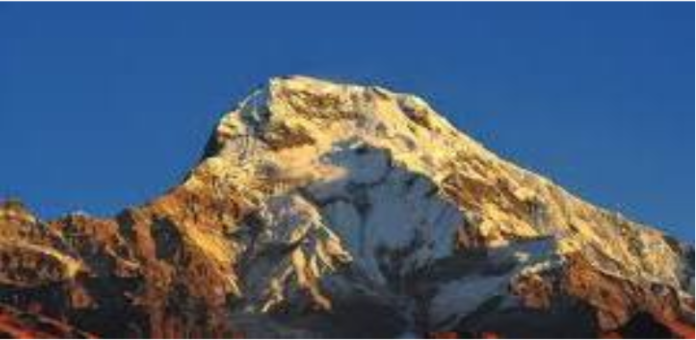Dhampus Peak (6,012m), situated in the Annapurna region of Nepal, is one of the best trekking peaks for climbers seeking an adventurous yet achievable Himalayan summit. This peak is an excellent choice for those looking to experience high-altitude climbing without requiring technical mountaineering skills. Offering breathtaking views of Dhaulagiri, Annapurna, and other majestic Himalayan ranges, Dhampus Peak Climbing is a rewarding challenge for enthusiastic trekkers and mountaineers alike.
Why Choose Dhampus Peak Climbing?
- Non-technical Climb: Unlike other trekking peaks, Dhampus Peak is relatively non-technical, making it ideal for beginners and intermediate climbers.
- Spectacular Panoramas: The climb offers mesmerizing views of the Annapurna and Dhaulagiri ranges, including Tukuche Peak and Nilgiri.
- Cultural Exploration: The trek passes through diverse ethnic villages of Gurung, Magar, and Thakali communities, allowing climbers to experience rich Nepalese culture.
- Acclimatization Opportunity: The route follows part of the famous Dhaulagiri Circuit, providing a gradual ascent to help climbers acclimatize properly.
Best Time for Dhampus Peak Climbing
The ideal seasons for Dhampus Peak Climbing are spring (March to May) and autumn (September to November). During these months, the weather remains stable, visibility is clear, and the trails are accessible.
Dhampus Peak Climbing Itinerary
Day 1-2: Arrival in Kathmandu & Preparation
- Arrive in Kathmandu and transfer to a hotel.
- Meet with the climbing guide and check gear.
- Obtain necessary permits.
Day 3-5: Drive to Pokhara & Trek to Italian Base Camp
- Take a scenic drive from Kathmandu to Pokhara (6-7 hours).
- Start the trek through beautiful Gurung villages.
- Reach Italian Base Camp for acclimatization.
Day 6-7: Trek to Dhampus Peak Base Camp
- Continue the trek to Dhampus Peak Base Camp.
- Rest and acclimatization at Base Camp.
Day 8: Summit Attempt & Return to Base Camp
- Early morning ascent to Dhampus Peak (6,012m).
- Enjoy panoramic Himalayan views from the summit.
- Descend back to Base Camp.
Day 9-11: Trek Back & Return to Pokhara
- Trek back through scenic trails.
- Drive to Pokhara and relax by Phewa Lake.
Day 12: Return to Kathmandu & Departure
- Drive or fly back to Kathmandu.
- Final departure or optional city sightseeing.
Required Permits & Costs
To climb Dhampus Peak, you will need:
- Annapurna Conservation Area Permit (ACAP)
- Trekkers’ Information Management System (TIMS) Card
- Peak Climbing Permit issued by the Nepal Mountaineering Association (NMA)
The estimated cost of the climb ranges from $2,000 to $3,500, depending on the services included, such as guides, porters, accommodation, meals, and equipment.
Physical Fitness & Preparation
- Cardiovascular Endurance: Engage in running, cycling, or hiking at least 4-5 times a week.
- Strength Training: Focus on leg and core workouts to build stamina.
- Altitude Training: Acclimatization hikes or simulated altitude training can help prepare for high elevations.
- Mental Preparedness: Climbing at high altitudes requires strong willpower and adaptability.
Essential Gear Checklist
- Climbing Equipment: Crampons, ice axe, harness, helmet, and trekking poles.
- Clothing: Down jacket, thermal layers, gloves, and waterproof gear.
- Footwear: High-altitude mountaineering boots.
- Other Essentials: Sleeping bag, headlamp, sunglasses, sunscreen, and a first-aid kit.
Safety Measures & Challenges
- Altitude Sickness: Acclimatization and hydration are crucial.
- Weather Conditions: Check forecasts and avoid summit attempts during storms.
- Technical Support: Hiring an experienced guide enhances safety.
Conclusion
Dhampus Peak Climbing is an unforgettable adventure that blends the thrill of mountaineering with Nepal’s rich cultural experiences. With breathtaking views, a non-technical yet challenging climb, and an immersive trekking experience, it remains a top choice for climbers worldwide. Whether you’re a seasoned trekker or a first-time climber, this peak offers an extraordinary Himalayan journey that is both rewarding and achievable.
FAQs
- Do I need prior climbing experience for Dhampus Peak?
No, Dhampus Peak is a non-technical climb suitable for trekkers with basic high-altitude experience. - What is the highest altitude reached during the climb?
The summit of Dhampus Peak stands at 6,012m. - How long does the Dhampus Peak Climbing trip take?
The entire expedition usually takes around 12-14 days. - What is the difficulty level of Dhampus Peak Climbing?
It is considered a moderate to challenging climb, requiring good physical fitness. - Can I rent climbing gear in Nepal?
Yes, you can rent climbing equipment in Kathmandu or Pokhara.
Key Takeaways
- Dhampus Peak (6,012m) is an accessible trekking peak in Nepal’s Annapurna region.
- Best climbed in spring and autumn for stable weather and clear visibility.
- Requires basic trekking skills, good fitness, and proper acclimatization.
- Offers breathtaking views of Annapurna, Dhaulagiri, and Nilgiri ranges.
- Permits & costs range from $2,000 to $3,500, depending on services included.
- A perfect peak for those looking to experience high-altitude adventure without technical mountaineering skills.
Embark on the adventure of a lifetime and conquer Dhampus Peak for an unforgettable Himalayan experience!
Contact Us :
Whatsapp Number: +977 9862854770 (Lakpa Sherpa)
Email : Info@uniquesherpatrek.
URL: www.uniquesherpatrek.com

